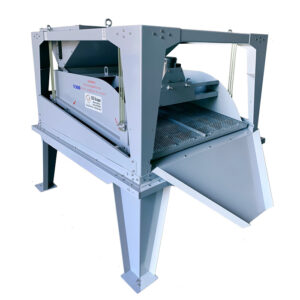Description
Scalpers are used to remove large trash, stems, leaves, and associated chaff prior to basic cleaning. There are numerous types, but they basically use the same style of cleaning. Raw material is metered onto a flat screen that is set at a slight incline and vibrated mechanically. Trash is removed as the seed fall through the holes in the screen and onto a second screen. This screen traps the seed and moves them to a hopper as smaller trash falls through the holes and is swept away by an air current. Another style uses a round drum made from a perforated metal screen set at a slight incline. As the drum rotates, seed fall through the screen and trash remaining in the drum is removed.
References / Additional Information
Desai, B.B.; Kotecha, P.M.; Salunkhe, D.K. 1997. Seeds handbook: Biology, production, processing, and storage. New York, NY: Marcel Dekker, Inc. 800 p.
Harmond, J.E.; Brandenberg, N.R.; Klein, L.M. 1968. Mechanical seed cleaning and handling. USDA Agricultural Handbook No. 354. Washington, DC: U.S. Department of Agriculture, Forest Service.
Jorgensen, K.R.; Stevens, R. 2004. Chapter 24. Seed collection, cleaning, and storage. In: Monsen, S.B.; Stevens, R.; Shaw, N.L., comps. Restoring western ranges and wildlands, vol. 3. Gen. Tech. Rep. RMRS-GTR-136-vol-3. Fort Collins, CO: U.S. Department of Agriculture, Forest Service, Rocky Mountain Research Station: 699-716.
Vaughan, C.E.; Gregg, B.R.; Delouche, J.C. 1968. Seed processing and handling. State College, MI: Mississippi State University, Seed Technology Laboratory.
Young, J.A.; Young, C.G. 1986. Collecting, processing, and germinating seeds of wildland plants. 3rd ed. Portland, OR: Timber Press. 236 p.


